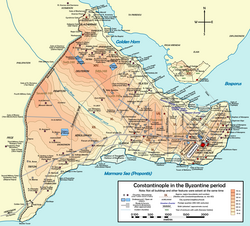Siege of Constantinople (1203)
This article needs additional citations for verification. (December 2008) |
| Siege of Constantinople | |||||||
|---|---|---|---|---|---|---|---|
| Part of the Fourth Crusade | |||||||
 Map of Constantinople during the Byzantine era | |||||||
| |||||||
| Belligerents | |||||||
|
|
| ||||||
| Commanders and leaders | |||||||
|
|
| ||||||
| Strength | |||||||
|
Crusaders: 10,000 men[1] Venetians: 10,000 men[1] and 210 ships[2] | 15,000 men[3] and 20 ships[4] | ||||||
The Siege of Constantinople in 1203 was a crucial episode of the Fourth Crusade, marking the beginning of a series of events that would ultimately lead to the fall of the Byzantine capital. The crusaders, diverted from their original mission to reclaim Jerusalem, found themselves in Constantinople, in support of the deposed emperor Isaac II Angelos and his son Alexios IV Angelos. The besieging forces, primarily composed of Western European knights faced initial setbacks, but their determination and advanced siege weaponry played a pivotal role in pressuring the Byzantine defenders.
Amidst the chaos, the Byzantine emperor was overthrown, leading to a power vacuum and setting the stage for the more infamous events of 1204 when the crusaders, frustrated by unpaid debts and political turmoil, eventually sacked the city. This marked the first time in nearly nine centuries that Constantinople fell to an external force, forever altering the course of Byzantine history.
Siege
To take the city by force, the Crusaders first needed to cross the
On 11 July the Crusaders took positions opposite the Blachernae palace on the northwest corner of the city.
Alexios III finally took offensive action, and led 17 divisions from the St. Romanus Gate, vastly outnumbering the Crusaders. Alexios III's army of about 8,500 men faced the Crusader's 7 divisions (about 3,500 men), but (according to Choniates and the Latins) his courage failed, and the Byzantine army returned to the city without a fight.[10]
On 18 July 1203 the Crusaders launched an assault on the city, and Alexios III immediately fled into Thrace. The next morning, the Crusaders were surprised to find that the citizens had released
After the 1203 siege
Following the end of the first siege of Constantinople in 1203, on 1 August 1203, the pro-Crusader Alexios Angelos was crowned Emperor
On 25 January 1204, the death of co-Emperor
See also
- Siege of Constantinople (1204)
- Siege of Constantinople (1235)
References
- ^ a b J. Phillips, The Fourth Crusade and the Sack of Constantinople, 269
- ^ J. Phillips, The Fourth Crusade and the Sack of Constantinople, 106
- ^ S. Blondal, The Varangians of Byzantium, 164
- ^ J. Phillips, The Fourth Crusade and the Sack of Constantinople, 159
- ^ Andrea, Alfred. Contemporary Sources For The Fourth Crusade. pp. 191–192.
- ^ Andrea, Alfred. Contemporary Sources For The Fourth Crusade. p. 193.
- ^ "The Fourth Crusade and the Fall of Constantinople". Geocities.com. Archived from the original on 2009-08-08. Retrieved 2008-12-30.
- ^ J. Phillip "The Fourth Crusade and the Sack of Constantinople", 208–209
- ^ J. Phillips, The Fourth Crusade and the Sack of Constantinople, 176
- ^ J. Phillips, The Fourth Crusade and the Sack of Constantinople, 177
- ^ David Nicolle, The Fourth Crusade 1202–04; The betrayal of Byzantium. Osprey Campaign Series No. 237. Osprey Publishing.
